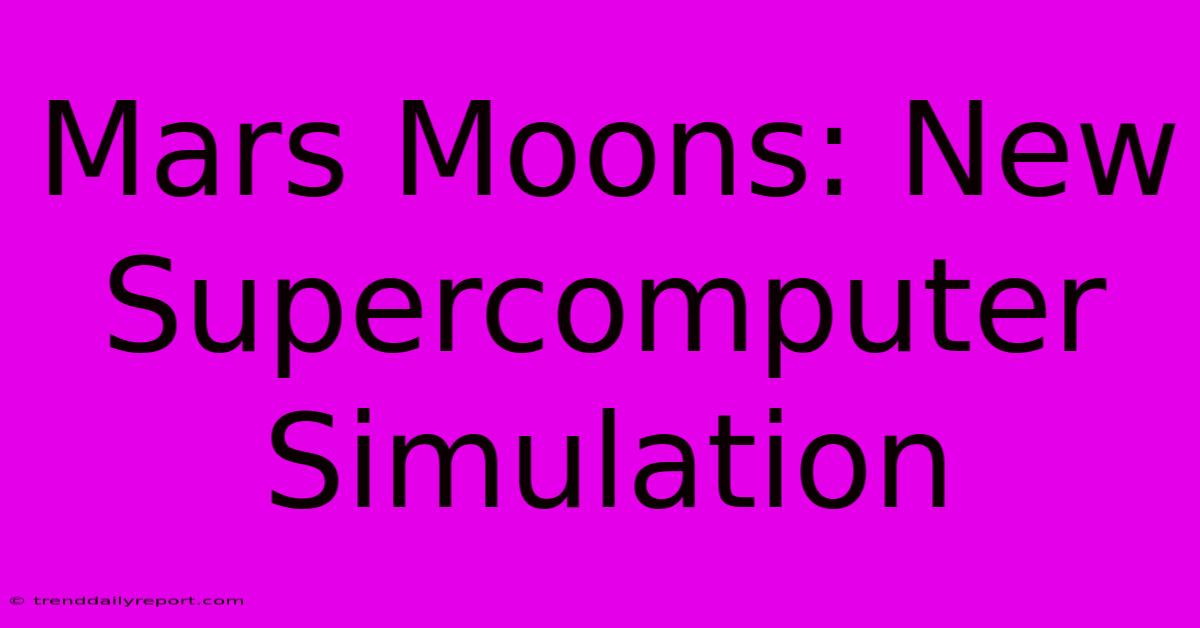Mars Moons: New Supercomputer Simulation

Discover more detailed and exciting information on our website. Click the link below to start your adventure: Visit Best Website Mars Moons: New Supercomputer Simulation. Don't miss out!
Table of Contents
Mars Moons: Decoding Phobos and Deimos with a Supercomputer Simulation
Hey everyone, so I've been totally geeking out lately over this new supercomputer simulation of Mars' moons, Phobos and Deimos. It's mind-blowing stuff, honestly. I mean, I’m no rocket scientist – far from it – but even I can appreciate the crazy detail they're getting into. This isn't just some boring old physics lesson; this could totally change our understanding of how these little guys formed.
<h3>A Personal Journey into Martian Moons</h3>
I remember back in college, I took this astronomy elective, thinking it would be a breeze. Boy, was I wrong! We spent weeks on the formation of planetary systems, and I struggled to grasp the complexities of accretion disks and gravitational interactions. I almost failed the mid-term on calculating orbital velocities - seriously, those equations were brutal. But then we got to Mars' moons, and something clicked. The mystery surrounding their origin – were they captured asteroids or something else entirely? – really got me hooked.
This new simulation, though, is on a whole other level. It uses incredibly powerful computers to model the gravitational forces, the impacts, and even the internal structure of these moons with a level of precision I never thought possible. Think of it like this: instead of just looking at a map of a city, you're actually flying over it in a helicopter, seeing every single house, every streetlight, everything.
<h3>Unraveling the Mysteries of Phobos and Deimos</h3>
The simulation's already starting to give us some seriously cool insights. For instance, earlier theories suggested that Phobos and Deimos were captured asteroids. But the new data challenges this! The simulation shows that the moons’ composition, their orbits, and the overall system dynamics don’t quite match what we'd expect from captured asteroids. This suggests that they may have formed in situ, meaning right there near Mars – perhaps from the debris left over after a massive impact.
Now, this isn't a definitive answer; science is a process, right? But the level of detail in this simulation is amazing. They're factoring in things like the moon's porosity – how much empty space is inside – which affects their gravitational behavior. They're even considering the influence of Mars’ own gravity and the subtle gravitational pull of the sun. It's like a giant, highly detailed puzzle box, and the scientists are carefully piecing it together.
<h3>Why This Matters: The Big Picture</h3>
Understanding the formation of Mars' moons isn't just some academic exercise. It tells us a lot about the early solar system, about how planets form and evolve, and how their surroundings affect their development. It has huge implications for our understanding of planetary science as a whole. Plus, figuring out the composition of these moons could be a major clue when planning future missions to Mars. We might even find resources there that we can use for our own space exploration efforts.
<h4>Practical Takeaways & Further Exploration</h4>
So, what can you take away from this? Well, firstly, it shows the power of supercomputing in scientific research. Technology is constantly pushing the boundaries of what we can learn, and that’s pretty awesome. Secondly, don’t be intimidated by complex science. It can seem overwhelming at first, but breaking it down into smaller, more manageable pieces, like I did with my astronomy class, makes it easier to digest. It’s okay to struggle; it's part of the learning process. And remember, even seemingly small celestial bodies like Phobos and Deimos can hold enormous scientific value.
Want to learn more? Search online for "Mars moon formation simulation," "Phobos and Deimos origin," or "supercomputer planetary simulations". There's a ton of readily available information out there! Let's keep exploring the mysteries of the cosmos, together!

Thank you for visiting our website wich cover about Mars Moons: New Supercomputer Simulation. We hope the information provided has been useful to you. Feel free to contact us if you have any questions or need further assistance. See you next time and dont miss to bookmark.
Featured Posts
-
Series Victory Ayubs Quick Fire Century
Nov 27, 2024
-
Stream Bayern Vs Psg November 26th
Nov 27, 2024
-
Ucl Visit Havant Mp Mak
Nov 27, 2024
-
Evan Ferguson Loan Move To Brighton
Nov 27, 2024
-
87 Year Old Freemans Rare Appearance
Nov 27, 2024
